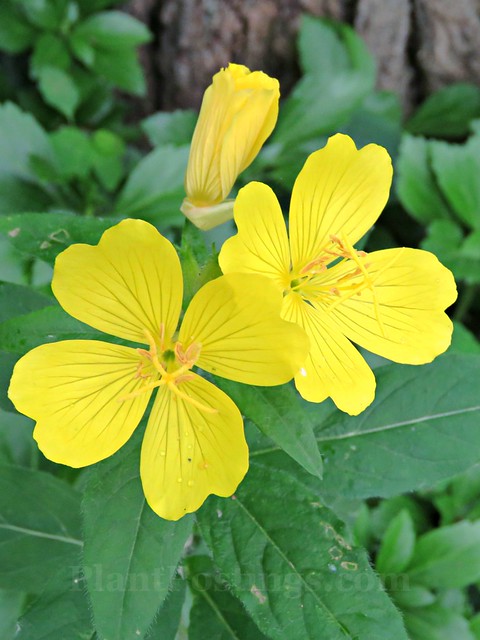
Most of the wildflowers in this garden lived here before we moved in, nearly 19 years ago. Prairie Sundrops (Oenothera pilosella) were among them. Also known as Meadow Evening Primrose, this plant has flowers that open during the day, unlike other species of the Evening Primrose family that close by midday.
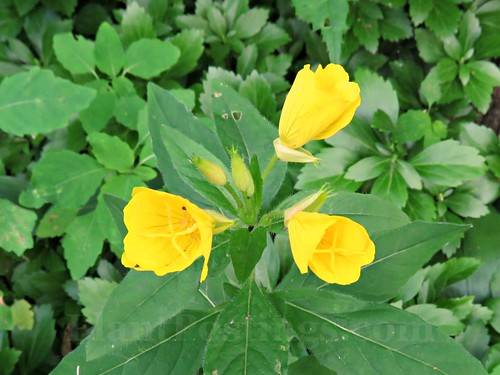
Prairie Sundrop spreads and can form dense mats. It also can be propagated with seeds.
In my garden, Prairie Sundrop is not aggressive; in fact, it's pretty much stayed in the same general area in the garden for all the years we've been here--in a small patch at the base of one of our old Oaks. It tends to bloom in mid-June through mid-July, and adds a burst of bright yellow just as some of the late spring flowers are fading. My patch is in dappled shade, although most sources recommend full sun to partial shade.
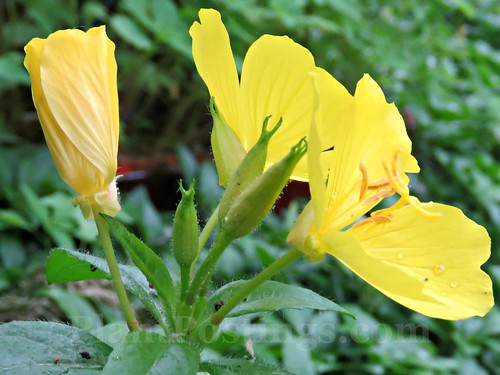
The 2" flowers are attractive in all their stages--from bud to bloom to closed flower. Each flower lasts only a few days, but the flower clusters bring new blooms for a couple of weeks.
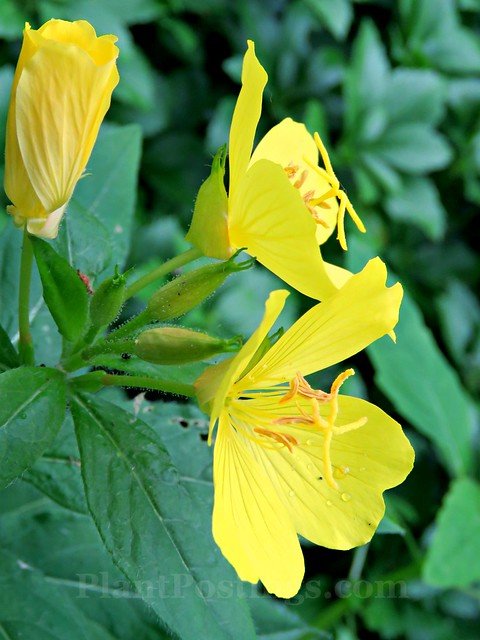
Other than its daytime blooms, this species is similar to Common Evening Primrose (O. biennis) and Narrowleaf Evening Primrose (O. fruticosa), but it's shorter (about 1' to 2' tall), and has hairy stems and fuzzy leaves. In addition, its fruit/seedpod tapers toward the base. Like the other species, each flower has a distinctive cross-shaped stigma. The pollen on the anthers turns reddish as the flower matures.
Prairie Sundrops are native from Eastern Canada through the Midwest and south through Louisiana and Texas. Some sources say they aren't native to Wisconsin, but USDA updated maps say they are (perhaps originally more in the southern part of the state). In any case, they prefer rich, wet mesic to dry mesic soils, according to the Eloise Butler Wildflower Garden Plant Identification Guide. The flowers are visited by bees, butterflies, and other pollinators. Like other Evening Primose species, this one is a host plant to several moth species.
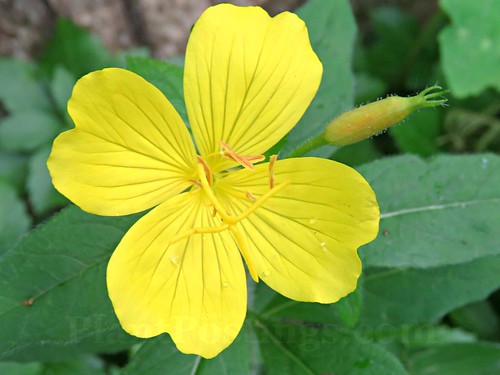
I like it. I take it for granted--of course, I shouldn't and I think I need to plant more or spread some seed.
I'm linking this post to Gail's Wildflower Wednesday meme at Clay and Limestone. Head on over to learn about wildflowers blooming around the world.
There are beautiful flowers in a sunny color that you have been around for years. It's good that they are not expansive and do not cause trouble. Greetings.
ReplyDeleteHi Giga: Yes, I actually really have taken them for granted. But now I feel like I want more, so I'll have to add some in a different spot. :)
DeleteSimple and lovely. Well behaved - it's a bonus!
ReplyDeleteAgreed! Apparently, in some gardens they spread more, but here with the dappled shade they've been staying in one spot.
DeleteYou can't miss with cheerful yellow flowers in my book! Our own native evening primrose, Oenothera speciosa, also opens during the day, despite the name. Ours is a pale pink and it spreads with abandon in the driest areas of the garden.
ReplyDeleteI really like the pink ones, too. I remember seeing lots of them in California and Texas. Such a lovely shade of pink!
DeleteI have one of those drops that open during the evening. Fun to watch them open. This one is a real beauty. What fun to that that perfect little sun during the day when you expect the sun.
ReplyDeleteThey seem to be especially healthy this year==maybe with all the rain we've had. They actually look bigger and more impressive. Now I want more!
DeleteBeautiful!
ReplyDeleteHappy Wildflower Wednesday!
Thank you, Lea! I don't think I'll be taking these Sundrops for granted anymore. ;-)
DeleteI adore these blooms. For me they bloom in May and are constantly visited by native bees. Like you, mine have remained in the same general area. Unlike the evening primrose that have spread everywhere.
ReplyDeleteI haven't noticed a ton of bee activity on them, but I think I have in past years. They're so pretty and cheerful, though, and I do think I've seen moth larvae on them.
DeleteEye candy and the bees enjoy it - perfect!
DeleteBeautiful to see the yellow flower:)
ReplyDeleteYes, this shade of yellow is very cheery!
DeleteAnd doesn’t that bright yellow ring in the cheer!
ReplyDeleteYes, it does, Lynne! They've been really healthy this year!
DeleteBeth, these are beautiful. I picked up a pink come-along oenothera when a friend was giving me a peony last year. It was so pretty I left it and now it is conqueror of the garden. Your yellow one is lovely and with its nice behavior I can see why you want to keep it.
ReplyDeleteI love the pink ones, too, Susie! I remember seeing quite a few of them in California and Texas.
DeleteWhat a cheerful yellow flower. What a treat!
ReplyDeleteYes, it is very pretty and seems to welcome in the heat of the summer. In a garden of mostly green (lots of shade), they really pop!
DeleteThank you for reminding me sundrops are native! Gave you a little link love! http://www.coldclimategardening.com/2018/06/28/sundrops-add-sunshine-to-my-garden-wildflower-wednesday/
ReplyDeleteThanks, Kathy! You certainly have a much bigger patch than I do. Aren't they cheery?!
DeleteThanks for writing about this one - I didn't know about this particular Oenothera. Sounds like it might do well in my garden. Now I have to see if they sell it at Prairie Moon.
ReplyDeleteYou're welcome, Jason. Yes, I do believe it would be very happy in your garden! Prairie Moon does sell it!
DeleteWe once had an Evening Primrose planted beside the porch steps at our previous house. My young sons played guessing games as to which bloom would open next. They got so good at guessing, they would have "count downs to lift-off" then cheer when the bloom opened. It was cheap entertainment on a warm summer night.
ReplyDeleteThanks for reminding me of a good memory.
Jeannie@GetMeToTheCountry
Oh how fun! I love those memories. I can think of so many wonderful "sibling" and "children" memories involving plants. I love the plant/game memories, too. :)
DeleteVery pretty! I have some type of Evening Primrose, though I don't know what type. It seeds around a little bit, which might be good as a bunch that is in my hell strip recently died. It looks incredible when all of them are in bloom.
ReplyDeleteYes, I thought this one was a different species until I examined it very closely. I love it, although I wish I had a bigger patch. I guess I'll have to work on that! ;-)
DeletePrairie Sundrops, what a pretty name. There are so many lovely members of the Evening Primrose family. I love them.
ReplyDeleteYes, I agree. They're all kind of underappreciated, I think. Or maybe I simply haven't appreciated them enough, myself, until recently. :)
DeleteWe have evening primroses in our garden as well - not sure if it's this same variety but mine do stay open all day. I'll be sure to check for those hairy stems/leaves.
ReplyDeleteOh, lucky you! I need more! I have taken my little patch of them for granted for too long.
DeleteThis is a June favorite of mine. It also works great as a cut flower. It continues to bloom after cutting.
ReplyDeleteI have so few that I haven't tried them as cut flowers yet--good to know! I'll have to grow more, so I'll have a bigger supply. :)
DeleteThey really are dollops of sunshine, aren't they?! Great shots!
ReplyDeleteYes, they are! And a bright color where it's hard to come by--dappled shade. Thank you, Tina. :)
DeleteWhat a cheerful bloom! It is a beautiful wildflower. You are fortunate it has established itself so well and yet is not overly aggressive. Perhaps the limited sunshine keeps it in bounds?
ReplyDeleteVery pretty. I love the cheerful yellow color and the ease of care!
ReplyDeleteBeautiful photos and great information about prairie sundrops! I didn't know they were so beneficial for pollinators. Thanks for sharing these gardening insights.
ReplyDelete